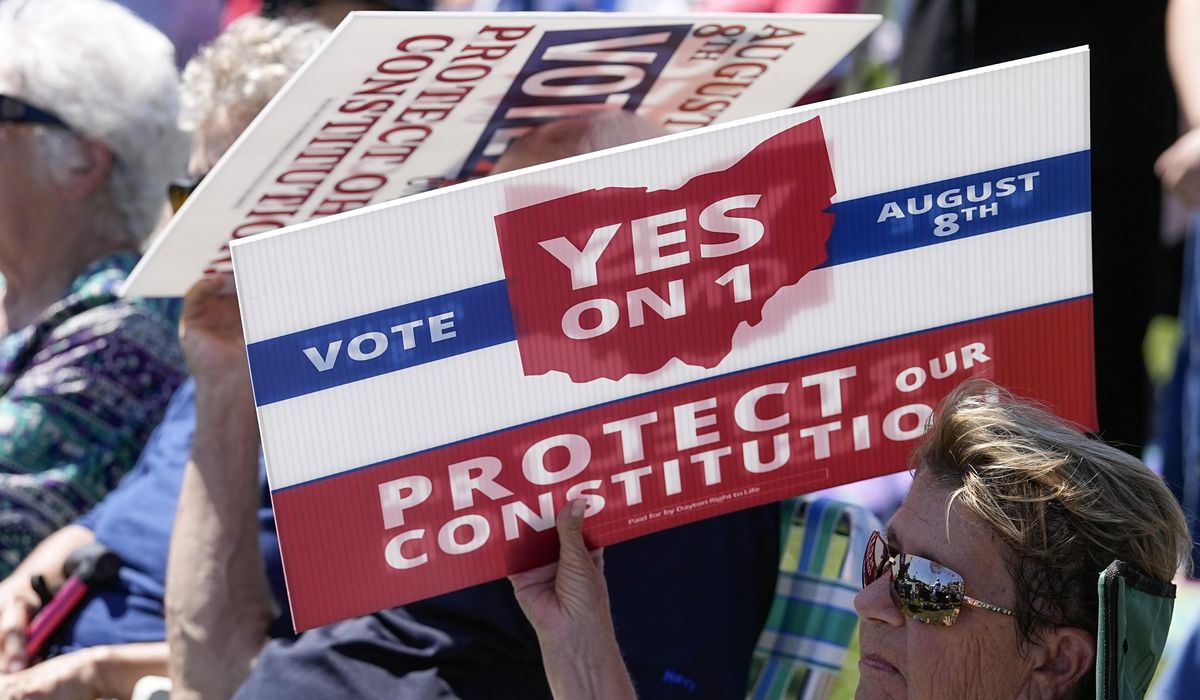Ohio will decide Tuesday whether changes to the state constitution will require the support of a simple majority or 60% of voters, and the outcome will have a major impact on a November fight over a pro-choice abortion measure.
Voters will be asked this fall whether a “fundamental right to reproductive freedom” should be added to the constitution as states navigate the fallout from the Supreme Court decision overturning Roe v. Wade.
Meanwhile, Republican lawmakers have scheduled an undercard fight this summer.
If Issue 1 passes, pro-choice advocates will have a harder time locking in abortion rights through a constitutional amendment because changes will require greater support than polls suggest.
A special election Tuesday asks voters to raise the support threshold for an amendment to pass and eliminates a 10-day “curing” period when citizen campaigns can collect additional signatures for ballot questions. It also doubles the number of counties from which signatures must be collected, from 44 to all 88.
The vote is drawing nationwide attention to Ohio, which has long been a swing state but has turned more Republican in recent years, and a flood of outside money from political interest groups.
“I’ve consistently said Issue 1 is about protecting Ohio’s constitution and that it would apply to every future proposed amendment, the most immediate being abortion, minimum wage, livestock agriculture, election integrity, and redistricting reform,” Ohio Secretary of State Frank LaRose, a Republican candidate for U.S. Senate who is pushing for a “yes” vote Tuesday, wrote in a recent piece for The Blade in Toledo.
David Pepper, a former chairman of the Ohio Democratic Party, said top Republicans are characterizing Issue 1 as a good-governance provision but their sole motivation is to defeat the abortion measure in November. He noted that pro-life advocates lost ballot battles in swing-state Michigan and Republican-heavy Kansas and Kentucky.
“It’s been hard for them to hide that that’s what it’s about,” Mr. Pepper said. “It’s obviously this is a desperate effort to change the rules.”
Abortion is legal until 20 weeks into pregnancy in Ohio. A legal stay is in place against a six-week limit approved in the wake of the 2022 Supreme Court decision in Dobbs v. Jackson Women’s Health Organization, which ended abortion as a federal constitutional right and returned the issue to the states.
Pro-choice groups believe the six-week threshold will be upheld eventually, so they are pushing the November measure to allow abortion to about 24 weeks into pregnancy — the fetal viability standard used in the 1973 Roe v. Wade decision.
The preliminary fight over the threshold for constitutional changes is significant because a Suffolk University/USA Today poll found that a majority of Ohio voters, about 58%, support the amendment — not enough to clear a 60% threshold.
Last year, ballot-driven efforts to shore up abortion access typically drew support from 50% to 60% of voters.
Mr. Pepper said Tuesday’s vote is “such an egregious power play” that it sparked pushback from a wide coalition of Democrats, Libertarians and Republicans, such as former Gov. John Kasich, a 2016 presidential candidate.
“It’s a massive coalition. It’s across party lines,” Mr. Pepper said.
Supporters of Issue 1 hope to stiffen the constitutional amendment threshold so that big-moneyed, out-of-state interests do not overwhelm the desires of Ohioans.
Outside money is flooding in anyway.
An Associated Press analysis found that a key group in support of Issue 1, Protect Our Constitution, received $4 million of its $4.8 million from Richard Uihlein, a wealthy Illinois businessman.
A group opposed to Issue 1, One Person One Vote, received nearly 85% of its donations from outside Ohio.
State-based groups are trying to win hearts and minds, too.
“Thousands of physicians across Ohio have made it clear, we must defeat Issue 1 on August 8th and pass the reproductive freedom amendment on November 7th to protect the health and safety of patients,” Pro-Choice Ohio Executive Director Kellie Copeland tweeted as the campaign heated up this summer.
Amy Natoce, a spokeswoman for pro-life Protect Women Ohio, said her organization formed in March to combat the November abortion measure but has spent $9 million on Issue 1.
“We’ve kind of been fighting on two fronts,” she said.
She said many states have higher thresholds than a simple majority for constitutional changes but Ohio is exposed to outside influence. She said the language in the November measure leaves fetal viability to the judgment of the pregnant woman’s doctor.
“It really leaves the door open to abortion on demand,” she said.
Mr. Pepper said the “no” side goes into Tuesday’s vote with an apparent advantage but the “yes” side could win because the election is in the lazy days of August.
“A low turnout election is very unpredictable,” he said.
At least on that, Mr. Pepper and Ms. Natoce agree.
“It’ll be a turnout election, as all issue campaigns are,” Ms. Natoce said. “We are confident that when Ohioans understand what Issue 1 is and how open Ohio’s constitution is to outside groups, they are 100% behind Issue 1.”


